Internet Connections
Introduction
Web pages that contain high-resolution photographic images or other types of media will be slow to download over dial-up connections. Downloading large audio or video files, application software, or ISO image files can take anything from one to several hours, or even days. The type of connection used will determine the maximum download (and upload) speed, measured in bits per second, and generally referred to as connection bandwidth. The connection types available will depend on the location of the subscriber, and how much they are prepared to pay. At the beginning of the millennium, most Internet access in the UK was through dial-up connections. Today, relatively cheap broadband Internet access is widely available, and has led to a huge increase in the demand for online services. This increased demand has in turn forced service providers to regularly increase the available bandwidth.
Broadband Internet access technologies include those that utilise the subscriber loop of the telephone system, and those that employ alternative transmission media such as cable or satellite microwave. A broadband Internet connection can be loosely defined as one that affords a higher data rate than a standard digital voice channel (i.e. greater than 64 kilobits per second). Using this definition, ISDN would not normally be considered a broadband technology, although it is significantly faster than dial-up, and has the added advantage of being able to provide simultaneous voice and data communication. The most widely deployed broadband technologies in the United Kingdom are ADSL, which utilises existing analogue telephone lines, and cable, which utilises the broadband cable TV network infrastructure developed from the mid 1990s onwards. Satellite-based Internet services are also available, although current offerings are significantly more expensive than either ADSL or cable services, and provide data rates that are significantly lower.
Dial-up connections
Dial-up Internet access is typically used by home users and small businesses who do not require high-speed Internet access, or who cannot currently receive broadband services.
To connect a computer to the Internet using a standard twisted-pair telephone line, a device known as a modem (MOdulator-DEModulator) is required. The modem provides an interface between the digital computer system and the analogue telephone system, and is sometimes referred to as an analogue modem to distinguish it from other types of modem. Binary data from the computer is sent to the modem, which uses it to modulate an analogue carrier wave with a signalling frequency (or baud rate) of 2400 hertz. Incoming signals must be demodulated to extract the binary data encoded within them so that it can be interpreted by the computer. The modem is connected to a telephone cable that plugs into a standard telephone wall socket. There are two basic types of modem - external and internal. An external modem is a self-contained unit that is connected to the computer via an RS232 serial communications port or a USB port (see below).
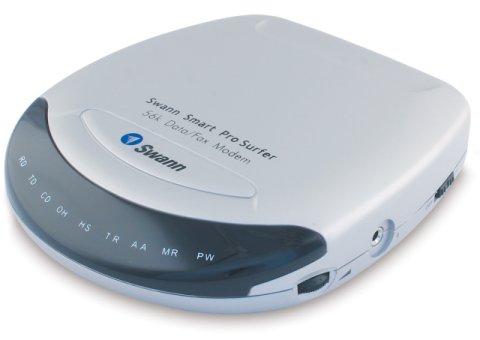
A modern external 56k data/fax modem
An internal modem for a personal computer fits into an expansion slot on the computer's motherboard in such a way that an RJ11 telephone socket is accessible at the back of the computer (see below). A cable with the appropriate type of connectors at each end is used to connect the modem to a telephone socket. The connector that plugs into the internal modem is known as an RJ11 connector. The connector on the other end of the cable is a standard BT431a telephone jack.
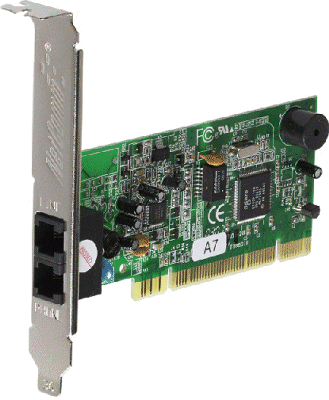
An internal fax modem
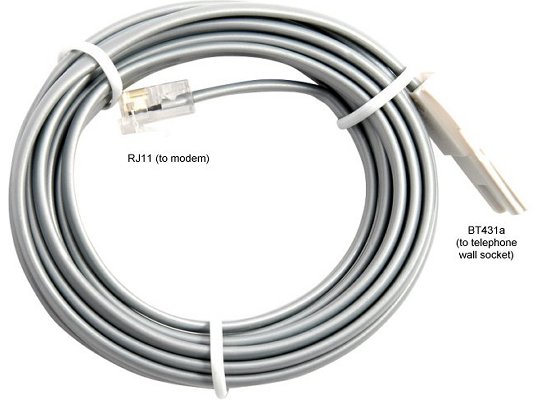
The modem is connected via a cable to a standard telephone outlet
Internal modems are relatively inexpensive and are usually designed to fit into a standard PCI expansion slot on the computer motherboard. Most PCI modems are software modems, because they rely on the computer's CPU to do some of the processing that was previously carried out by components built into the older hardware modems, which were quite large, and designed to fit into the older ISA expansion slots. As a result, PCI modems are usually much smaller.
Most modern modems operate at a nominal maximum data download rate of 56 kbps, using the V90 protocol. The nominal maximum upload rate is less (33.6 kbps). Analogue telephone lines can actually only handle data speeds of up to 33.6 kbps (the usable bandwidth frequencies are in the range 300 Hz to 3300 Hz). For rates of up to 56 kbps to be achieved, data compression schemes are used in addition to the various modulation techniques. Although these maximum data rates are theoretically possible, they are not achieved in practice due to line noise and imperfections in the transmission system. Download rates of 48 kbps can generally be considered good.
Establishing a connection between two modems involves a handshaking process in which coded signals are exchanged for the purpose of coordinating the connection. The FallBack method is used to find a mutually acceptable method of communication. The calling modem first tries to connect at its highest speed (or using its best error-correction or data compression scheme). If the called modem does not respond positively (i.e. signal back to confirm that it can handle that protocol), the calling modem falls back to a slower speed or less effective scheme and tries to connect again. This cycle continues until common ground is found or they run out of options. The two modems can subsequently renegotiate the connection speed up or down, depending on the prevailing line conditions at any given time.
PCMCIA (Personal Computer Memory Card Internetional Association) modems are designed for laptop computers, and fit directly into a PCMCIA slot on the outside of the portable device.
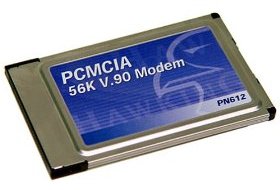
A PCMCIA modem is designed to fit into a laptop computer
Integrated Services Digital Network (ISDN)
Most modern telephone exchanges are fully digital, and the core telephone network carries both digitised voice data and all other forms of binary data over high-bandwidth fibre optic cables. Analogue voice signals arriving at a local telephone exchange via a caller's subscriber line (or local loop) must be digitised before they can be sent through the digital exchanges and trunk lines that make up the core telephone network. They must later be converted back into an analogue signal in order to be sent along another analogue local loop to the remote subscriber's telephone. ISDN essentially provides a digital subscriber loop, replacing the bandwidth-restricted analogue circuit with a digital circuit using existing twisted-pair telephone lines.
ISDN comes in two main flavours - Basic Rate Interface (BRI) and Primary Rate Interface (PRI). PRI is used widely by businesses to provide multiple digital telephone lines (up to 30 channels down a single 2.048 Mbps (E1) coaxial cable or optical fibre). BRI is delivered over a single wire pair from a digital switch at the local exchange to the network termination (NT) at the customer's premises, and consists of two B (bearer) channels of 64kbps each for data, and one D channel of 16kbps which is used for setting up and clearing down calls, or communicating with the telephone network. The BRI service can be used to provide two telephone lines, but the main reason we are interested in it is that it is commonly used to provide a single digital telephone line and a 64kbps digital Internet connection (although the two B channels can be bonded together to provide a single 128 kbps data channel). The diagram below shows a BRI connection.
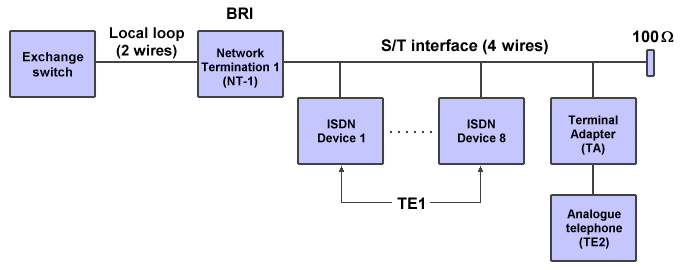
A BRI connection
At the subscriber's premises, the NT1 device provides the interface between the 2-wire incoming telephone line and the 4-wire S/T interface, which is essentially a bus topology terminated with a 100W resistor. Up to eight ISDN Terminal Equipment 1 (TE1) devices can be connected to the S/T interface, although only two digital channels are available at any one time. If an analogue Terminal Equipment 2 (TE2) device (such as an analogue telephone) is required to be connected, a Terminal Adapter (TA) must be used between the S/T interface and the TE2 device.
The connection time for an ISDN line is fast (approximately half a second or so) by comparison with the connection time required for an analogue dial-up connection. In addition, each channel has a guaranteed bandwidth of 24kbps, and telephone calls can be made without disrupting Internet access (and vice versa). A computer is a non-ISDN device, and as such requires a terminal adapter (an ISDN modem or router) in order to connect to the ISDN network.
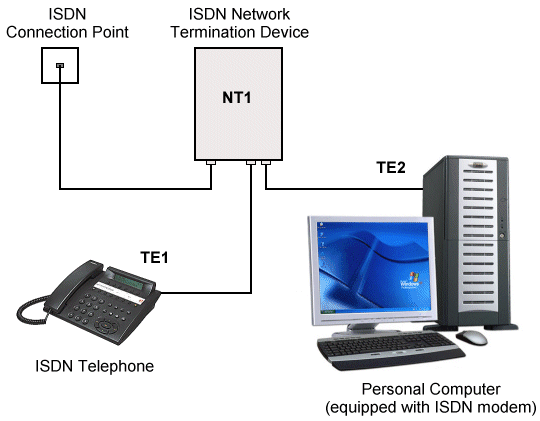
A typical ISDN setup
Basic rate ISDN services have been widely used in Europe to provide digital telephony and Internet access. High installation costs and rental charges have discouraged their use for Internet access in the UK, and cheap broadband cable and DSL services have rendered ISDN largely obsolete as a viable alternative for Internet access.
Asymmetric Digital Subscriber Line (ADSL)
Digital subscriber line broadband services in the UK take the form of ADSL (asymmetric DSL) and operate over standard twisted pair telephone lines. The use of analogue telephone lines imposes limitations on how far from the exchange subscribers can be and still receive ADSL broadband service. ADSL is still not available everywhere, but installation and service costs have fallen as connection speeds have increased, making ADSL a viable alternative to cable for high-speed Internet access. ADSL provides an always-on connection for a standard monthly charge. Furthermore, the channels used for Internet data use a completely different set of frequencies to that used for voice communication, so phone calls and Internet traffic can share the same telephone line simultaneously without interfering with one another.

An ADSL connection
The asymmetric nature of ADSL means that the downstream bandwidth (i.e. from the exchange to the subscriber's premises) is far greater than the upstream bandwidth (from the subscriber's premises to the exchange). This is acceptable to most non-business subscribers, since they tend to download far more data than they upload. It also takes advantage of the fact that crosstalk at the exchange is far greater than at the subscriber's premises, simply because of the large number of twisted pair telephone lines entering the exchange in close proximity to one another.
The lower end of the frequency spectrum (26 - 138 kHz) is therefore used to transmit data in the upstream direction, since signals at these frequencies will degrade far less due to attenuation and therefore not be so susceptible to crosstalk at the exchange. The higher frequency band (138 kHz - 1.1 MHz) is used to transmit the downstream data, and has a sufficiently high signal-to-noise ratio (SNR) as it leaves the exchange to ensure that the signal can be detected by the subscriber's equipment. The much broader range of frequencies available for downstream transmission allows a much higher date rate in this direction.
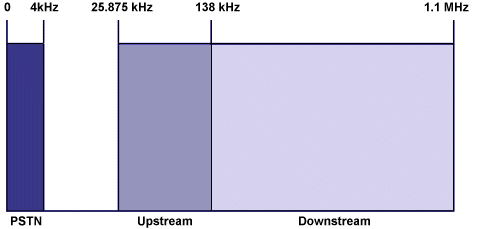
The ADSL frequency spectrum
The maximum data rates currently being quoted for standard ADSL are 8Mbps download speeds and 1Mbps upload speeds. The upload data rate can be increased by increasing the bandwidth of the upstream channel, at the expense of the downstream channel. ADSL2 specifications use frequencies up to 2.2 MHz, effectively doubling the bandwidth and providing theoretical maximum downstream data rates of up to 24 Mbps. It should be noted, however, that these higher frequencies are far more susceptible to attenuation, which means that the higher date rates could only be achieved if the subscriber was within two kilometers or so of an ADSL-enabled exchange.
In fact, distance from the exchange is the main factor that determines whether or not a subscriber can obtain an ADSL connection. Because attenuation due to external interference can be worse on some frequencies than on others, the upstream and downstream channels are sub-divided into a number of 4.3125 kHz channels. When the ADSL modem is turned on, it tests each sub-channel to determine which of the available channels has an acceptable signal-to-noise ratio. Channels with a high error rate will not be used, resulting in a reduction in throughput but significantly reducing the incidence of data transmission errors (the actual throughput achieved is dependent on the number of sub-channels that are usable).
One of the other benefits of ADSL, as opposed to either dial-up or ISDN connections, is that it is an always-on service, eliminating the need for call set-up. The subscriber typically has an ADSL modem or an ADSL router provided by the ISP, which connects user's PC via a USB port or via an Ethernet network interface card (NIC) using a Category 5 patch cable. The ISP usually provides one or more ADSL splitters (or microfilters). A splitter allows a single telephone outlet to be connected to both a standard analogue telephone and an ADSL modem or router. The splitter filters out the ADSL frequencies from the telephone connection using a low-pass filter, and filters out the telephone frequencies from the ADSL modem connection using a high-pass filter. A basic analogue telephone service will thus always be available, even if the Internet connection fails.
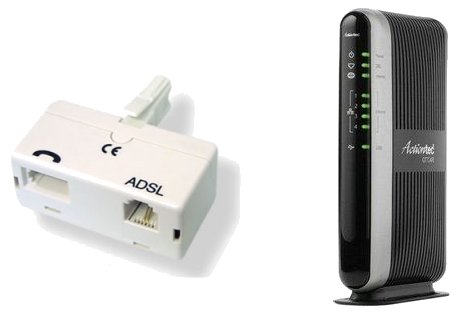
An ADSL microfilter (left) and an Actiontec GT724R DSL modem/router (right)
At the telephone exchange the line generally terminates at a digital subscriber line access multiplexer (DSLAM). ADSL data is typically routed over the telephone company's data network, and from there to an Internet backbone network. British Telecom's ADSL service sends data via its ATM data network to its main Internet backbone, the Colossus IP network.
Cable
Like ADSL, cable broadband Internet services are available at a relatively low cost, and provide an always-on connection. Unlike ADSL, distance from the service provider's premises is not a significant issue, and the distance between the modem and the service provider's Cable Modem Termination System (CMTS) can be as much as 160 kilometres. Download data rates of up to 20 Mb are currently being offered, although cable services are only available in areas with an existing cable television infrastructure. The cable service cannot use existing telephone wiring, and requires a coaxial drop cable to be installed and terminated inside the subscriber's premises.
Cable broadband subscribers require a cable modem. Cable Internet services are usually bundled with cable TV services, since both are supplied to the subscriber's premises using the same coaxial cable. A splitter is usually installed in a junction box on the outside of the premises to separate the two, with one coaxial cable coming from the splitter to the cable modem. The cable modem can be connected directly to a single PC via a USB cable or to either a PC or a router using a Cat5 Ethernet cable (a connection of this sort to a PC would require a NIC to be installed in the PC). A cable modem-router may be used instead of a separate modem and router. Although sharing the same physical enclosure, the cable modem function and the router function will each have their own separate IP and MAC addresses.
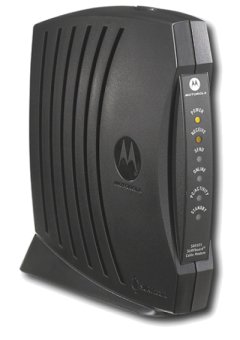
A Motorola SURFboard Cable Modem-SB5101
The subscribers in a given neighbourhood will effectively share a fixed channel capacity, and the service may become slower for individual subscribers if large numbers of people are using the service at the same time. The available bandwidth must be shared fairly between subscribers using statistical multiplexing. The service provider must monitor usage, and scale the network provision from time to time to maintain an acceptable level of service to subscribers, even during periods of heavy demand. Service providers such as Virgin Media use various bandwidth-limiting techniques to regulate the amount of data downloaded by individual subscribers at peak times, especially if they have consistently downloaded a large volume of data over a period of time.
A cable modem termination system (CMTS) is usually found in a cable provider's headend. A headend is a facility for receiving TV signals for processing and distribution to subscribers over the local cable infrastructure, and is typically a large unmanned building housing the equipment used to receive and re-transmit television signals. It will normally have a number of satellite dishes for the reception of satellite broadcasts (usually one dish is required for each satellite from which broadcasts are to be received). There may also be other types of antenna to receive local terrestrial TV broadcasts. A CMTS provides similar functionality in a cable system as a DSLAM in the ADSL system. Signals enter the CMTS from the internet via high capacity links through an Ethernet interface, and emerge on the other side as radio frequency (RF) signals via a coaxial/RF interface. The RF signal carrying the Internet data is then combined with the television signal, and transmitted via cable to the subscriber's premises, where a splitter separates the Internet data from the television signal once more. The RF Internet data is sent to the subscriber's cable modem via one coaxial cable, while the TV signal is sent to a set top box via another coaxial cable. Each CMTS can manage the Internet traffic for thousands of subscribers, and any given headend may have a number of CMTSs.
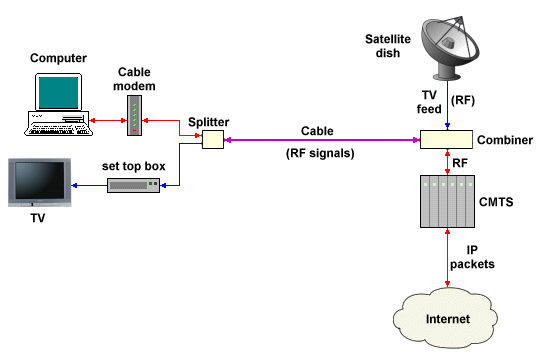
A cable system
Satellite
Satellite Internet access tends to be far more expensive than its terrestrial counterparts, and while it is several times faster than dial-up or ISDN internet connections, it does not offer anywhere near the data rates available with ADSL or cable. The main benefit of satellite technology is that it can be used in locations where other forms of Internet access are not available. The main disadvantages are the inherent delays (generally referred to as latency) involved in sending signals via a microwave repeater mounted on a satellite that is approximately 35,000 kilometres above the earth's surface, and the fact that some of the high frequencies used to transmit signals to and from the satellite can be adversely affected by heavy rain and other atmospheric conditions. Satellite systems are not well suited to applications such as online gaming or VoIP, where high latency can cause degraded performance or even dropped connections.
One form of satellite Internet access employs a one-way satellite link that also requires the use of a dial-up Internet connection. Downstream data (from the Internet to the subscriber) are received via a satellite downlink at relatively high data rates (compared to dial-up). Upstream data (from the subscriber to the Internet) is not sent via the satellite, but is instead sent to the ISP's office using a standard dial-up connection via an analogue telephone line. The upload speed is thus limited to the 33 kbps theoretical maximum data rate for a dial-up upstream connection, and in reality the upstream data rate is likely to be much lower.
Two-way satellite connections allow data from the subscriber to be sent to the Internet via a satellite uplink, although some two-way systems also employ a conventional dial-up Internet connection to carry traffic that is less dependent on high-bandwidth than it is on low latency. The satellite uplink and downlink channels are reserved for traffic where high bandwidth is the priority, and latency is not an issue. In the UK, British Telecom offer a satellite broadband service called BT Business Satellite that provides an always-on Internet connection that is not dependent on a dial-up connection, with upload speeds of up to 128 kbps and download speeds of up to 512 kbps.
The BT system uses a geo-stationary satellite in orbit over the equator. A small two-way VSAT (very small aperture terminal) satellite dish is mounted on a wall or roof at the subscriber's premises with unobstructed line-of-sight to the satellite, and is connected via two coaxial cables to a satellite modem inside the subscriber's home or office. The dish is used to transmit upstream data to the satellite and to receive downstream data. The satellite communicates with a BTOpenworld hub, which has a high-capacity link to the Internet. One or more computers (up to four per connection with BT's service) are connected to the satellite modem. If only one computer is connected to the modem, the connection can utilise either a USB or Ethernet cable. If more than one computer is connected, the connection to the modem must be made via a suitable router. The diagram below illustrates the paths that the data must follow between a subscriber's home or office network and the Internet.
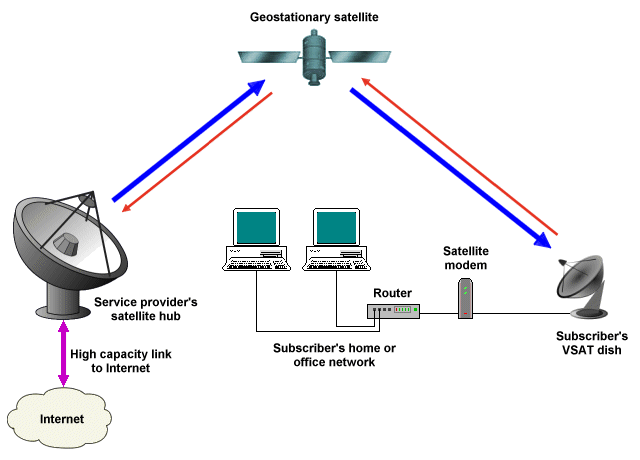
A VSAT-based satellite system
Internet connection via a LAN
A connection to the Internet can be made by a client computer on a local area network (LAN) if the LAN has an Internet connection. A network router is usually required to provide the appropriate interface between the LAN and the Internet. The LAN's Internet connection will usually be provided by an ISP, and can be any of the preceding connection types. Bear in mind, however, that the clients on the network with access to the Internet will be sharing the Internet connection bandwidth. The type of Internet connection chosen should reflect the amount of Internet traffic that will pass through it, since it represents a potential bottleneck for traffic into and out of the LAN. If a significant number of clients require Internet access at the same time, individual response times will slow significantly, especially if some users are uploading or downloading large amounts of data. One obvious answer to the problem is to provide additional high-speed Internet connections, although this will have cost implications.
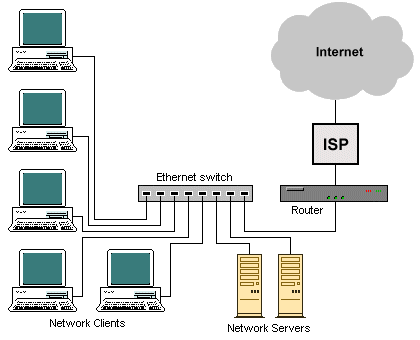
A typical LAN-Internet connection
